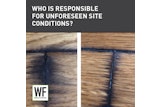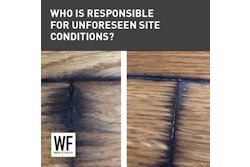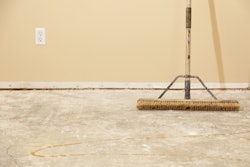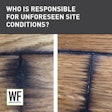Wood floor guys are pretty good with the tools of their trade. However, there are certain tools in the business side of contracting that are often overlooked and misunderstood. One of the better tools for protecting the contractor's right to payment is the mechanic's and materialman's lien, or lien for short. Use a lien correctly and you'll be taking an important step in protecting your chances of getting paid for your work and materials.
What is a Lien?
A lien is a document that announces to the world that the contractor has performed some work on a property and, as a result, has a legal interest in the property until paid. When the lien is against real estate (residential or commercial), it must be recorded in the county where the real estate is located.
The contents of the lien vary from state to state but, generally, at a minimum, the lien has to identify the contractor, owner and, sometimes, the lender. It should also state the amount the contractor is owed and contain a legal description of the real estate.
A legal description identifies the precise location and dimensions of the real estate. Most of the time the description will be a "meets and bounds" type, whereby the county is broken up into various quadrants that have been surveyed by a land surveyor. From a point of reference, measurements are taken to a beginning point on the property line, and then from there the property is described in distances and compass directions from point to point.
Does it Guarantee Payment?
Unfortunately, a lien is not a guarantee of payment. Instead, it merely grants the contractor a "security interest" in the real estate. That is, if the owner is not paying the contractor, the contractor can use the lien as a means to collect what he is owed.
As a contractor, generally, you have a right to payment for the value of your work, which often is defined by the terms of the contract. But to actually collect the money you are owed when the owner refuses to pay, you usually have to file a lawsuit. This is because you need some impartial person to decide whether you are entitled to be paid and, if so, how much. Though you believe that the owner owes you the full contract price, the owner who refuses to pay usually believes that they have a reason for not paying. Of course, you should try to resolve that dispute with the owner prior to filing a lawsuit, but if you cannot, a lawsuit is often your next step. As part of that lawsuit, if you have a lien against the real estate, you will assert your right to have the property sold to pay you. The process for the forced selling of the real estate is foreclosure.
A prime factor to consider when deciding whether to record a lien, and thereafter whether to file a lawsuit to foreclose, is whether there is adequate equity in the property such that you can get paid from the proceeds of the judicially forced sale. Each state applies its mechanic's lien laws a bit differently, and each state differs in the process for assigning priority to different liens. For example, if you know that the owner borrowed money to buy the property and that the loan is secured by the property (by mortgage or deed of trust), that lender's claim will generally be ahead of yours. If you proceed to lien and then foreclose, the proceeds from the sale of the property will have to first be paid to the lender, and whatever is left over may be paid to you. There may be other lender's or mechanic's liens that are higher in priority than yours. So, you need to have an idea of the property's value and the value of the other liens to decide whether it makes sense to enforce your lien, since there is no point in foreclosing if you get paid nothing for the effort.
After you have gone through the lawsuit process, a judge will make a final decision as to what you are owed. As part of the judgment, the judge may order the real estate be sold at a public auction. If the auction occurs (usually the owner will pay to avoid losing the real estate), the money from the sale is used to pay the amount you are owed on your contract and the amount of any other liens on the property. What is left is paid to the owner.
In the favorable event that you're paid in full after completing your work, then you need to record a release of lien. This is a document that basically says, "I've been paid in full on the lien and no longer have a claim to the real estate."
Lien Requirements
Some states require a notice be given to the owner at the outset of the project to let the owner know that the contractor has the right to lien. Contractors, particularly those working with homeowners, often worry that telling their customers that they have the right to lien for payment will cause the owner to cancel the contract. That can and does happen. Generally, a contractor can handle the situation by explaining to the owner that the lien is standard business practice and is simply a way to protect the right to payment, the same as any lender would do under the circumstances (after all, if you are not being paid in-full up front, you are lending your time and labor to the improvement of the owner's property). If the owner is not satisfied after such an explanation, then as a contractor you have a business decision to make: Do you trust this owner enough to forego the lien? Remember that not every job is worth having, and a customer who is uncooperative at the start is not likely to improve as the job progresses.
The requirements to lien real estate vary from state to state and are generally set by a state's statutes or codes. Several states require the contractor to provide some form of notice prior to the lien, generally at (or near) the outset of the job. Additionally, some states require a contractor be licensed to be able to sue. In those states, if you are unlicensed, you have no right to collect at all, let alone record a lien. Also, be aware that recording an improper lien could result in your paying the owner damages far greater than you are owed.
There are lien service companies available to assist with the process, but remember that ultimately you are responsible for the liens recorded on your behalf. When in doubt, consult an attorney.
Business Q & A by Jim Blasingame
Q: What types of assets can serve as collateral for a bank loan?
A: Collateral is assets that can be pledged to a lender in the event of a loan default. It can include real estate (personal or business), equipment, cash (such as in a CD), inventory or accounts receivable. However, some forget that collateral can sometimes be augmeted by goodwill, or trust you've built with your banker through the years. This can often add leverage to physical collateral.
Jim Blasingame is the creator and award-winning host of the nationally syndicated radio/Internet talk show, "The Small Business Advocate," and author of Small Business is Like a Bunch of Bananas and Three Minutes to Success. Find Jim's show and more at www.SmallBusinessdAdvocate.com, plus instant answers to your questions at his small business knowledgebase, www.AskJim.biz.

































